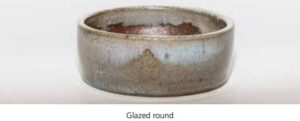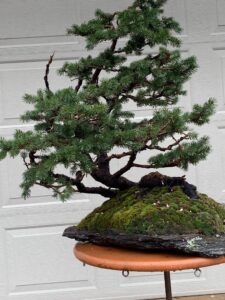By: Charlotte Field—February 2021
From a professional ballerina to a respected Bonsai Pro, Jennifer Price totally enjoys her life’s journey. As she shares her thoughts, I found her to be an honest, devoted, sincere person totally at ease with life, herself and The Art of Bonsai.
Over 11 years ago she saw her first bonsai and she bought it. She didn’t have a real connection with it, just thought it was a pretty tree. I asked her if she still had it, and like most of us she said with a sad laugh, “No I killed it.” She had taken an outdoor Juniper indoors and couldn’t figure out why it died. She was at Goers Greenhouse where she met Dan Kosta and he told her about Prairie State. She now has 22 trees and since she travels a lot, she prefers quality over quantity. For the last 3 years she has been demoing and teaching and of course still learning.
Q: What is your most prized tree?
A: an old hemlock I got in my first workshop.
Q: Like Children we do not want to admit a favorite but among your collection, do you have a favorite?
A: it becomes the tree you are working with as one delves deeper into styling and begins to see the beauty within. My weakest species has also become a favorite as I struggled with junipers early on I now enjoy the challenge they present.
Q: Do you prefer outdoor or tropical bonsai or both and why?
A: both really. Not a lot of bonsai artists do tropicals. It’s really nice to have a killer Juniper next to a blooming bougainvillea, beautiful.
Q: When you first started into bonsai, what did you enjoy the most about the art and has that changed over the years?
A: Coming from a dance background I saw the movement in the trees. I still see the dance and the movement within the trees. That has not changed.
Q: What was the hardest thing you had to learn or master in doing bonsai?
A:Wiring…I used to be intimated with wiring but I am fine with it now. practice…practice….practice
Q: How did you feel the very first time you had to cut off a major branch?
A: fine, I had no issues with it. But it’s important to have a design and a reason for doing it.
Q: When you first look at a raw tree, do you immediately know what you will be doing with it or does your vision develop over time?
A: immediately, and then as the tree continues to grow in my garden, you change and conceptionalize and as the tree changes you change with the tree. That’s the exciting part of bonsai, it’s an ever changing living art.
Q: You do a lot of carving. how did you get into that part of the art?
A: Thanks to Walter pall….I was in a workshop he was teaching, I was intimidated, all the men had their tools, I said to Walter “I dont know what to do, I am at a loss”, he said “Then we shall make you a carving expert.”
Q: You have studied and demoed in all parts of the world. when the plague lifts where are you off to next and is there a country you have not been to yet that you would like to visit and study in?
A: i have several places I’m looking forward to returning to. Both Germany and Sweden as well as having the opportunity to present workshops and demos in Australia and Brazil. I have never been to Spain and would someday like to see David Benavente’s collection. As far as studying I have committed to working with Ryan Neil for the next several years as well as continuing my apprenticeship with Walter Pall.
Q: Who would you consider the most influential in helping you get started on your bonsai journey?
A: Dan Kosta from our club first introduced me to bonsai. We joke that I am either thanking or cursing Dan. Jim Doyle has been a major influence and continues to be along with Walter Pall.
Q: You have worked with some of the finest bonsai pros in the world. do you have any favorites and why?
A: Of course Walter pall, he continues to mentor and challenge me and makes me think outside the box. He has a “sink or swim” attitude but helps when needed. Ryan Neil, I enjoy working with him. He has so much knowledge.
Q: What are your favorite genus of trees to work on?
A: While it’s hard not to fall in love with the tree you are working with, I am partial to deciduous (maples, beech) as well as spruce
Q: Are there any forms of bonsai you pre.fer over the others? what do you think of mame bonsai?
A: I tend to have bigger trees, being influenced by Walter and Ryan. Sometimes I think I should get into Mame, it would make life easier. I really like the naturalistic style and working with American species of trees.
Q: What do you consider yourself…a master, a pro, an enthusiast?
A: A pro and a student always. The artform lends itself to being a student. I don’t care for the word Master. Master means you have completely finished something.
Q: How do you feel about being one of only a very few female bonsai pros in a field dominated by men?
A: It has been a challenging learning curve. At times one feels that the reason one is asked to an event is to be the token female. I have had to work hard to get past that. There are currently less that five female professionals in the world. I do feel a heavy weight to stand on my own as an artist and not just be the token female.
Q: Has bonsai changed the way you ap.proach and live your life. basically your philosophy of life?
A: Yes, it’s made me appreciate nature and I believe centers me. I also enjoy working with the diverse group of people I have had the opportunity to teach.
Q: What in your opinion are the most important qualities a bonsai artist should have?
A: Patience….A thorough technical knowledge of the technique of working with trees…..a horticultural background. If you don’t understand or know how to grow them, how can you take them to the next level….and artistry
Q: Any tips or advice you can give to a seasoned bonsai hobbyist?
A: Never stop learning. If you continue learning you continue to grow as an artist.
Q: What advice would you give someone new to bonsai, someone just starting out?
A: Pick one main teacher. Meaning, that while I am a big advocate of taking every workshop one can it is important to listen to one main voice, Otherwise one can become confused with different theories on everything from pruning to simple styling techniques. Your eye will also change as you grow with the art form so try to hold yourself back from buying too much in the beginning. Keep a journal and take photos. This will help in writing down what you have learned, questions as well as a record of what you have done and when. It’s also fun to look back on.
Q: How about tools for a newby into bonsai?
A: Good scissors, Wire cutters, gin pliers, and in the beginning, use annealed aluminum wire. It is easier to work with and more forgiving on the tree, especially with deciduous trees.
Q: in conclusion give me 3 words that de.scribe how you feel about bonsai or how it makes you feel?
A: Constantly evolving ( living ) art
LEARN MORE ABOUT JENNIFER PRICE
Check out Jennifer’s works on her facebook page:
https://www.facebook.com/profile.php?id=100014187977256



